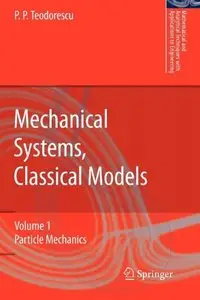"Mechanical Systems, Classical Models. Volume I: Particle Mechanics" by Petre P. Teodorescu
MATHEMATICAL AND ANALYTICAL TECHNIQUES WITH APPLICATIONS TO ENGINEERING
Springer | 2007 | ISBN: 1402054416 1402054424 9781402054419 | 783 pages | PDF/djvu | 15/11 MB
MATHEMATICAL AND ANALYTICAL TECHNIQUES WITH APPLICATIONS TO ENGINEERING
Springer | 2007 | ISBN: 1402054416 1402054424 9781402054419 | 783 pages | PDF/djvu | 15/11 MB
The guideline of the book is precisely the mathematical model of mechanics. Starting from the particle (the simplest problem) and finishing with the study of dynamical systems (including bifurcation, catastrophes and chaos), the book covers a wide number of problems (classical or new ones).
The book is divided in three volumes:
I. Particle mechanics.
II. Mechanics of discrete and continuous systems.
III. Analytical mechanics.
CONTENTS I. Particle mechanics
PREFACE
1. NEWTONIAN MODEL OF MECHANICS
1. Mechanics, science of nature. Mechanical systems
1.1 Basic notions
1.2 Mathematical model of mechanics
2. Dimensional analysis. Units. Homogeneity. Similitude
2.1 Physical quantities. Units
2.2 Homogeneity
2.3 Similitude
2. MECHANICS OF THE SYSTEMS OF FORCES
1. Introductory notions
1.1 Decomposition of forces. Bases
1.2 Products of vectors
2. Systems of forces
2.1 Moments
2.2 Reduction of systems of forces
3. MASS GEOMETRY. DISPLACEMENTS. CONSTRAINTS
1 Mass geometry
1.1 Centres of mass
1.2 Moments of inertia
2 Displacements. Constraints
2.1 Displacements
2.2 Constraints
4. STATICS
1 Statics of discrete mechanical systems
1.1 Statics of the particle
1.2 Statics of discrete systems of particles
2 Statics of solids
2.1 Statics of rigid solids
2.2 Statics of threads
5. KINEMATICS
1 Kinematics of the particle
1.1 Trajectory and velocity of the particle
1.2 Acceleration of the particle
1.3 Particular cases of motion of a particle
2 Kinematics of the rigid solid
2.1 Kinematical formulae in the motion of a rigid solid
2.2 Particular cases of motion of the rigid solid
2.3 General motion of the rigid solid
3 Relative motion. Kinematics of mechanical systems
3.1 Relative motion of a particle
3.2 Relative motion of the rigid solid
3.3 Kinematics of systems of rigid solids
6. DYNAMICS OF THE PARTICLE WITH RESPECT TO AN INERTIAL FRAME OF REFERENCE
1 Introductory notions. General theorems
1.1 Introductory notions
1.2 General theorems
2 Dynamics of the particle subjected to constraints
2.1 General considerations
2.2 Motion of the particle with one or two degrees of freedom
7. PROBLEMS OF DYNAMICS OF THE PARTICLE
1 Motion of the particle in a gravitational field
1.1 Rectilinear and plane motion
1.2 Motion of a heavy particle
1.3 Pendulary motion
2 Other problems of dynamics of the particle
2.1 Tautochronous motions. Motions on a brachistochrone and on a geodesic curve
2.2 Other applications
2.3 Stability of equilibrium of a particle
8. DYNAMICS OF THE PARTICLE IN A FIELD OF ELASTIC FORCES
1 The motion of a particle acted upon by a central force
1.1 General results
1.2 Other problems
2 Motion of a particle subjected to the action of an elastic force
2.1 Mechanical systems with two degrees of freedom
2.2 Mechanical systems with a single degree of freedom
9. NEWTONIAN THEORY OF UNIVERSAL ATTRACTION
1 Newtonian model of universal attraction
1.1 Principle of universal attraction
1.2 Theory of Newtonian potential
2 Motion due to the action of Newtonian forces of attraction
2.1 Motion of celestial bodies
2.2 Problem of artificial satellites of the Earth and of interplanetary vehicles
2.3 Applications to the theory of motion at the atomic level
10. OTHER CONSIDERATIONS ON PARTICLE DYNAMICS
1 Motion with discontinuity
1.1 Particle dynamics
1.2 General theorems
2 Motion of a particle with respect to a non-inertial frame of reference
2.1 Relative motion. Relative equilibrium
2.2 Elements of terrestrial mechanics
3 Dynamics of the particle of variable mass
3.1 Mathematical model of the motion. General theorems
3.2 Motion of a particle of variable mass in a gravitational field
3.3 Mathematical pendulum. Motion of a particle of variable mass in a field of central forces
3.4 Applications of Meshcherskiĭ’s generalized equation
APPENDIX
1 Elements of vector calculus
1.1 Vector analysis
1.2 Exterior differential calculus
2 Notions of field theory
2.1 Conservative vectors. Gradient
2.2 Differential operators of first and second order
2.3 Integral formulae
3 Elements of theory of distributions
3.1 Composition of distributions
3.2 Integral transforms in distributions
3.3 Applications to the study of differential equations. Basic solutions
REFERENCES
SUBJECT INDEX
NAME INDEX
with TOC BookMarkLinks



